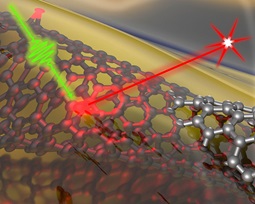An April 12, 2016 news item on ScienceDaily describes a use for carbon nanotubes in the field of quantum encryption,
Critical information, ranging from credit card numbers to national security data, is sent in streams of light, or laser pulses. However, the data transmitted in this manner can be stolen by splitting out a few photons (packets of light) from the laser pulse. Such eavesdropping could be prevented by encoding the data into single photons. But that requires generating single photons. Researchers demonstrated a new material, made from tiny carbon tubes, that emits the desired photons at room temperature.
A March 31, 2016 US Department of Energy news release, which originated the news item, explains the concept in more detail,
Digital eavesdropping could be prevented by encoding bits of information in the properties, or quantum mechanical states, of single photons. Single photons emitted by carbon nanotubes altered, or doped with oxygen, are especially attractive for realizing this quantum information technology.
Summary
Single photon generation requires an isolated, quantum mechanical, two-level system that can emit only one photon in one excitation-emission cycle. While artificial nanoscale materials (such as quantum dots and vacancy centers in diamonds) have been explored for single photon generation, none have emerged as the ideal candidate that meets all of the technological requirements. These requirements include the ability to generate single photons in the 1.3 to 1.5 µm fiber optic telecommunication wavelength range at room temperature. Earlier studies revealed that carbon nanotubes were not suited for use in quantum communications because the tubes required extremely low temperatures and had strong photoluminescence fluctuations. In contrast to these earlier findings, researchers led by Han Htoon and Stephen Doorn of the Center for Integrated Nanotechnologies showed that oxygen doping of carbon nanotubes can lead to fluctuation-free photoluminescence emission in the telecommunication wavelength range. Experiments measuring the time-distribution of two successive photon emission events also unambiguously demonstrated single photon emission at room temperature. Furthermore, because oxygen doping is achieved through a simple deposition of a silicon dioxide layer, these doped carbon nanotubes are fully compatible with silicon microfabrication technology and can be fabricated into electrically driven single photon sources. In addition, the silicon dioxide layer encapsulating the nanotubes allows for their easy integration into electronic and photonic integrated circuits. Beyond the implementation of this new method into quantum communication technologies, nanotube-based single photon sources could enable other transformative quantum technologies, including ultra-sensitive absorption measurements, sub-diffraction imaging, and linear quantum computing.
The researchers have provided an illustration of doped carbon nanotubes,

The deposition of a silicon dioxide layer (yellow layer) on a carbon nanotube (gray spheres) introduces solitary oxygen dopants (red spheres). A single photon (red and white star) is emitted when a dopant is excited by a laser pulse (green arrow). Image courtesy of the Center for Integrated Nanotechnologies
Here’s a link to and a citation for the paper, which was published a surprisingly long time ago,
Room-temperature single-photon generation from solitary dopants of carbon nanotubes by Xuedan Ma, Nicolai F. Hartmann, Jon K. S. Baldwin, Stephen K. Doorn, & Han Htoon. Nature Nanotechnology 10, 671–675 (2015) doi:10.1038/nnano.2015.136 Published online 13 July 2015
This paper is behind a paywall.